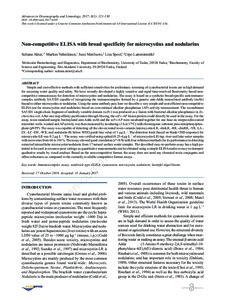Non-competitive ELISA with broad specificity for microcystins and nodularins
Sultana Akter; Markus Vehniäinen; Jussi Meriluoto; Lisa Spoof; Urpo Lamminmäki
https://urn.fi/URN:NBN:fi-fe2021042717403
Tiivistelmä
Simple and cost-effective methods with sufficient sensitivities for preliminary screening of cyanobacterial toxins are in high demand for assessing water quality and safety. We have recently developed a highly sensitive and rapid time-resolved fluorometry based noncompetitive immunoassay for detection of microcystins and nodularins. The assay is based on a synthetic broad-specific anti-immunocomplex
antibody SA51D1 capable of recognizing the immunocomplex formed by a generic anti-Adda monoclonal antibody (mAb) bound to either microcystins or nodularins. Using the same antibody pair, here we describe a very simple and cost-efficient non-competitive ELISA test for microcystins and nodularins based on conventional alkaline phosphatase (AP) activity measurement. The recombinant SA51D1 single-chain fragment of antibody variable domain (scFv) was produced as a fusion with bacterial alkaline phosphatase in Escherichia coli. After one step affinity purification through His-tag, the scFv-AP fusion protein could directly be used in the assay. For the assay, toxin standard/sample, biotinylated anti-Adda mAb and the scFv-AP were incubated together for one hour on streptavidin-coated microtiter wells, washed and AP activity was then measured by incubating (1 h at 37°C) with chromogenic substrate para-nitrophenylphosphate (pNPP). The assay was capable of detecting all the eleven tested toxin variants (microcystin-LR, -dmLR, -RR, -dmRR, -YR, -LA -LY, -LF -LW, -WR, and nodularin-R) below WHO guide line value of 1 μg L–1. The detection limit (based on blank+3SD response) for microcystin-LR was 0.2 μg L–1. The assay was verified using spiked (0.25-4 μg L–1 of microcystin-LR) tap, river and lake water samples with recoveries from 64 to 101%. The assay showed good correlation (r2>0.9) with four reference methods for its performance in detecting extracted intracellular microcystin/nodularin from 17 natural surface water samples. The described easy-to-perform assay has a high potential to be used in resource-poor settings as quantitative measurements can be obtained using a simple ELISA reader or easy-to-interpret qualitative results by visual readout. Based on the non-competitive format, the assay does not need any chemical toxin conjugates and offers robustness as compared to the currently available competitive format assays.
Kokoelmat
- Rinnakkaistallenteet [27094]
